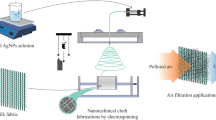Abstract
Micellar enhanced ultrafiltration (MEUF) and activated carbon fiber (ACF) hybrid processes were used to investigate the removal condition of lead ions and surfactant sodium dodecyl sulfate (SDS) from an aqueous solution. Lead removal efficiency increased with the increase of initial surfactant concentration. Molar ratio of lead to SDS up to 1: 5 has shown over 90% removal efficiency of lead, and the optimum molar ratio of lead to SDS was found to be 1: 5. Lead removal efficiency increased with the increase of pH, while it was maintained below 30% without surfactant. Lead removal was mainly due to the adsorption mechanism and no secondary layer was formed to reduce the flux. Lower molecular weight cut-off (MWCO) membrane has shown higher removal efficiency than higher MWCO one. Permeate flux decreased with the increase of molar ratio of lead to SDS. Flux decline was mainly due to the accumulation of micelles on the membrane surface. The presence of copper as a co-existing heavy metal highly affected the lead removal while nickel did not. Two sets of ACF unit in series were able to remove SDS surfactant effectively from the effluents of MEUF process.
Similar content being viewed by others
References
S. L. Lawniczak, P. Lecomte and J. J. Ehrhardt, Environ. Sci. Technol., 35, 1350 (2001).
K. Baek and J.W. Yang., J. Hazard. Mater., B(108), 119 (2004).
R. Bade and S. H. Lee, Environ. Eng. Res., 13(2), 98 (2008).
R. A. Goyer and I. J. Chisolon, Academic Press, New York/London (1972).
S. H. Lee and J. H. Jang, Environ. Eng. Res., 18(2), 130 (2004).
S. N. Bhat, G. A. Smith and E. E. Tucker, Ind. Eng. Chem. Res., 26, 1271 (1987).
L. Shu, S.H. Lee and V. Jegatheesan, Environ. Eng. Res., 17(2), 75 (2002).
V. Jegatheesan, S. H. Lee, C. Visvanathan, L. Shu and M. Marzella, Environ. Eng. Res., 4(4), 283 (1999).
S. Ahmadi, Y. C. Huang and B. J. Betchelor, Environ. Eng., 121, 645 (1995).
S. R. Jadhav, N. Verma, A. Sharma and P. K. Bhattacharya, Sep. Purif. Technol., 24, 541 (2001).
D. Chandan, S. D. Gupta and D. Sirshendu, Physicochemical and Engineering Aspects, 318, 125 (2007).
J. F. Scamehorn and J. H. Harwell, Marcel-Dekker Inc., New York (1989).
C. K. Liu, C.W. Li and C.Y. Lin, Chemosphere, 57, 629 (2004).
S. D. Christian, J. F. Scamehorn and R. T. Ellington, Marcel Dekker, New York (1989).
S. H. Lee, S. Vigneswaran and K. H. Ahn, Environ. Eng. Res., 13(4), 353 (1997).
J. Bahdziewicz, M. Bodzek and E. Wasik, Desalination, 121, 139 (1999).
M. K. Purkait, S. D. Gupta and S. De, J. Colloid Interf. Sci., 207, 259 (2004).
R. Bade and S. H. Lee, Korean J. Chem. Eng., 24(2), 239 (2007).
X. Chai, G. Chen, P. L. Yue and Y. Mi, J. Member. Sci., 123, 235 (1997).
K. Beak, B.K. Kim, H. J. Cho and J.W. Yang, J. Hazard. Mater., 99(3), 303 (2003).
J.W. Yang, K. Beak, K. B. Kim and H. J. Cho, International Water Association, Delhi, 1155 (2003).
L. Gzara and M. Dhahbi, Desalination, 137, 241 (2001).
G. Ghosh and P. K. Bhattacharya, Chem. Eng. J., 119, 45 (2006).
C. Brasquet, E. Subrenat and P. Le cloirec, Water Sci. Technol., 39(10–11), 201 (1999).
R. Bade, S. H. Lee, S. S. Jo, H. S. Lee and S. E. Lee, Desalination, 229, 264 (2008).
C. Jarusutthirak and G. Amy, Water Sci. Technol., 43(10), 225 (2001).
APHA, Americal Public Health Association, Washington D.C. (1998).
H. J. Kim, K. T. Beak, J. Lee, I. J. Iqbal and J.W. Yang, Desalination, 191, 186 (2006).
P. Gagliardo, S. Adham and R. Trusell, Water Sci. Technol., 43, 139 (2001).
H. Shin and S. Kang, Water Sci. Technol., 47, 139 (2002).
J. S. Yang, K. Baek and J.W. Yang, Desalination, 185(1–3), 385 (2005).
K. M. Lipe, D. A. Sabatini, M. A. Hasegawa and J. H. Harwell, Ground Water Monit. Rem., 16(1), 85 (1996).
J. F. Scamehorn and J. H. Harwell, Marcel Dekker, New York (1998).
B. R. Fillipi, J. F. Scamehorn, R.W. Taylor and S.D. Christian, Sep. Sci. Technol., 32, 2401 (1997).
UCLA, Magnetostrictive Materials Background, Active Materials Lab., Geoffrey P.McKnight (1994).
C. C. Tung, Y. M. Yang, C. H. Chang and J. R. Maa, Waste Manage., 22(7), 695 (2002).
B. R. Fillipi, L.W. Brant, J. F. Scamehorn and S. D. Christian, J. Colloid Interf. Sci., 213, 68 (1999).
Author information
Authors and Affiliations
Corresponding author
Rights and permissions
About this article
Cite this article
Son, G., Lee, S. Application of micellar enhanced ultrafiltration and activated carbon fiber hybrid processes for lead removal from an aqueous solution. Korean J. Chem. Eng. 28, 793–799 (2011). https://doi.org/10.1007/s11814-010-0427-9
Received:
Accepted:
Published:
Issue Date:
DOI: https://doi.org/10.1007/s11814-010-0427-9




